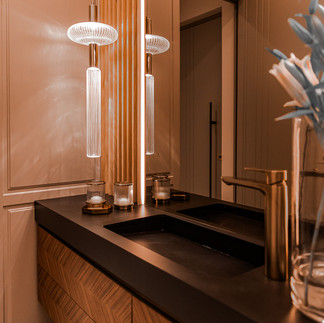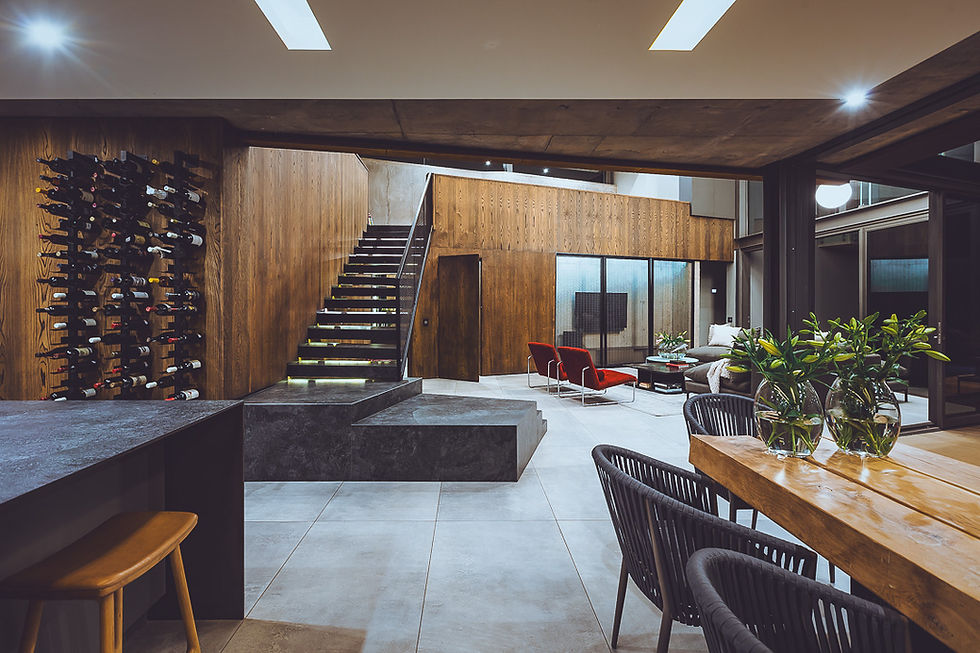Acoustic Design in Interiors: Sound Matters More Than You Think
- Theo Arewa-Bothma

- Jun 7
- 7 min read
How Thoughtful Acoustic Interior Design Elevates Luxury Living Through Comfort, Privacy, and Serenity
Step into a flawlessly curated interior; plush textures underfoot, sculptural lighting casting golden shadows across artisanal stone, and the scent of aged timber softly lingering in the air. It’s a space designed for elegance, for ease, for experience.
But then, something disturbs the stillness.
The echo of your own footsteps feels jarring. Conversation bounces from wall to ceiling. A distant hum of traffic creeps in through the glazing. Suddenly, the silence you expected is conspicuously absent, and so is the comfort.
At Studio 8687, we believe that true luxury isn’t always visible. It’s felt in the atmosphere, in the balance of stillness and sound. And yet, acoustic design remains one of the most underappreciated layers of residential interiors. For high-net-worth individuals investing in bespoke living environments, be they glass-encased villas on the Atlantic coast or penthouse retreats in the heart of the city, this element can be the quiet hero that transforms a beautiful space into a sanctuary.
This article explores the overlooked world of acoustic design, not through the lens of engineering, but through the lived experiences of those who value discretion, serenity, and uncompromising comfort. We’ll reveal how refined soundscaping through materials, spatial planning, and emerging technologies can turn any high-end home into a symphony of peace.
Understanding Acoustics: Why Sound Matters in Luxury Interiors
When we design at Studio 8687, we don’t simply consider what a space looks like, we curate how it feels. And feeling, more often than not, is shaped by sound. While visuals command immediate attention, acoustics silently sculpt the experience of a room. They are the unseen architecture that dictates calm, intimacy, and discretion. Picture hosting a private wine tasting in your drawing room: the soft murmur of conversation, the delicate clink of crystal stemware, the rustle of linen, all meant to drift gently through the air. But without acoustic balance, these sounds become chaotic, echoing off hard surfaces and disrupting the sense of ease. The elegance is still there, but the moment feels compromised.
At the core of acoustic comfort are three key principles: absorption, reflection, and insulation. Absorption is the art of softening sound. Materials like wool rugs, velvet drapes, or boucle-clad furnishings act like visual hush; they capture sound rather than allow it to ricochet. Reflection, on the other hand, can become problematic, especially in the context of contemporary luxury. Think expansive glazing, honed marble, polished concrete, surfaces that visually stun but acoustically clash if not counterbalanced. And then there’s insulation, the silent barrier that keeps the rhythm of the home compartmentalised. It’s what allows the media room to roar with surround sound while the adjacent suite remains wrapped in silence.
For our clients, luxury is not defined by ornamentation; it’s defined by intentionality. If a space doesn’t support conversation, privacy, or rest, then its beauty is only skin deep. Acoustic design isn’t a technical afterthought; it’s an essential layer of comfort and elegance that high-performance homes require. When done well, it disappears into the design narrative, enhancing every moment without ever drawing attention to itself.
Material Matters: Designing with Softness, Strength, and Silence
In luxury interiors, materials carry more than visual weight; they carry emotional resonance. At Studio 8687, we’ve always believed that the tactile and the auditory are intrinsically linked. The same velvet that tempts the fingertips can also soften the acoustics of a space. The right material doesn’t just look beautiful; it absorbs, diffuses, and balances sound in a way that feels effortless and deeply comforting.
Soft materials play a vital role in curating acoustic harmony. Upholstered walls, custom area rugs, and layered drapery aren’t just indulgent, they’re intentional.
But softness doesn’t mean fragility. The art lies in finding materials that offer both durability and discretion. Wool, for instance, is one of our studio’s go-to fibres, not just for its sustainability and warmth, but for its excellent acoustic absorption. Paired with layered window treatments, acoustic panels upholstered in artisanal fabrics, or custom wall coverings made from recycled textile composites, these materials offer elegance and performance in equal measure. And for our clients who demand discretion as well as design, solutions like these allow us to conceal acoustic treatments within cabinetry, behind artworks, or even as sculptural ceiling installations.
It’s also worth considering material placement. Acoustic design doesn’t require every surface to be soft, but it does require balance. We often approach interiors like musical compositions: moments of quiet (soft textures and plush upholstery) contrast with sharper notes (stone, glass, metal) to create rhythm. The key is in the layering; of surfaces, of materials, of moods.
This isn’t about muting life; it’s about refining it. Because in a truly luxurious space, every detail should serve a dual purpose: to elevate both the aesthetic and the experience. And the materials you choose? They are the instruments that play that symphony in silence.
Spatial Planning: Designing for Flow, Privacy, and Acoustic Balance
In the most elegant homes, space is never merely occupied; it’s orchestrated. Just as a conductor balances the notes of a symphony, a well-composed interior balances openness and intimacy, movement and pause, sound and stillness. At Studio 8687, we approach spatial planning not just as a tool for form and function, but as a vital element in shaping how sound travels and how it is contained.
Open-plan living may be the hallmark of contemporary luxury, but it also presents a unique acoustic challenge. High ceilings, seamless stone flooring, and interconnected zones can amplify noise, making everyday moments; conversation, dining, even the preparation of a morning espresso, feel unnecessarily loud or exposed. The solution isn’t to sacrifice openness, but to sculpt it with intention.
Strategic zoning, varied ceiling heights, and thoughtful circulation patterns also play their part. Transitioning from a double-volume gallery hallway into a softly curved corridor slows sound and movement alike. Positioning bedrooms away from primary entertaining spaces ensures serenity at all hours. Even the use of staircases, whether open tread or enclosed, can alter how sound flows vertically through a home.
Privacy, too, is an acoustic luxury. In high-end residences, it’s not just about what you hear, it’s about what you don’t. The hum of HVAC systems, the clatter of a caterer in the kitchen, the echoes of footsteps on stone can all erode the sense of peace. Spatial planning, when guided by acoustic principles, can mitigate these disruptions through the clever use of buffer zones, acoustic seals, and even quiet vestibules between primary spaces.
Ultimately, a space that is thoughtfully planned for sound feels like it breathes at the right pace. It supports both conviviality and retreat. It invites energy in, but only on your terms. And for our clients, that kind of control is the quietest expression of luxury there is.
Acoustic Technology: When Innovation Enhances Serenity
In homes where discretion is a virtue and ambiance is everything, technology should be invisible but impactful. At Studio 8687, we see innovation not as a disruption to design, but as an opportunity to fine-tune it. Nowhere is this more true than in the realm of acoustic technology.
Gone are the days when acoustic treatments were clunky panels reserved for corporate boardrooms or recording studios. Today’s solutions are not only more effective, they’re beautiful. And for our clients, that means achieving extraordinary acoustic performance without compromising on aesthetic purity.
Take integrated acoustic panels, for example. These aren’t just functional; they’re sculptural. Custom installations can double as art pieces or blend seamlessly into millwork, crafted from sustainable timbers, recycled felt, or even 3D-printed biopolymers that mimic organic textures. In one of our recent Alpine villa projects, we worked with a sound-engineering firm to embed thin, micro-perforated acoustic panels behind raw silk wall coverings. The result? A salon that retains its opulence while absorbing the quiet complexities of social sound; conversation, laughter, music, without a hint of echo.
There’s also growing interest in dynamic systems, like adjustable acoustic walls and smart glass that modulates sound transmission at the flick of a switch. These technologies are particularly valuable in multifunctional spaces: a library that transforms into a cocktail bar, or a wellness room that shifts between meditation and movement. In these moments, silence becomes programmable, a luxury that responds to lifestyle in real time.
Even ceiling systems have evolved. Acoustic baffles and clouds can now be suspended like floating art, tailored in finishes that match stone, timber, or textile palettes. Paired with directional speaker arrays and ambient sound masking systems, these tools allow us to shape the acoustic profile of each room with precision; enhancing privacy, mood, and overall comfort.
Our philosophy is simple: technology should never announce itself. It should work quietly, invisibly, elegantly, like a whisper behind the curtain. And when it comes to acoustics, this discretion is perhaps the ultimate sign of sophistication.
For the high-net-worth individual whose home reflects their taste, identity, and lifestyle, acoustic technology offers control without clutter and serenity without sacrifice. It’s a marriage of design and science, wrapped in silence.
In the world of high-end interiors, every detail is curated with intent; light, texture, proportion, and palette. But the most powerful luxury often isn’t what you see; it’s what you don’t hear. It’s the absence of echo in a voluminous hall. The softened murmur of a dinner party. The deep, calming hush of a bedroom at midnight. Acoustics are not the final layer of a space; they are its foundation, shaping the emotional texture of your home as intimately as light or form.
Through purposeful spatial planning, material mastery, and discreet integration of technology, we can design environments that not only look exquisite but feel profoundly serene. Homes that don’t just impress, but soothe. Homes where silence is shaped with the same precision as a marble counter top or a bespoke joinery detail.
At Studio 8687, we design for the way you live, not just the way you look. Because when sound is considered with care, it amplifies everything else: comfort, privacy, elegance, ease. And in the quiet of a well-designed space, what truly matters has room to resonate.













Comments